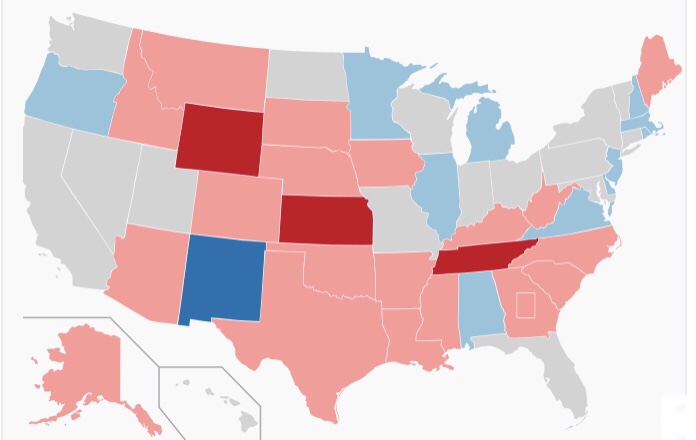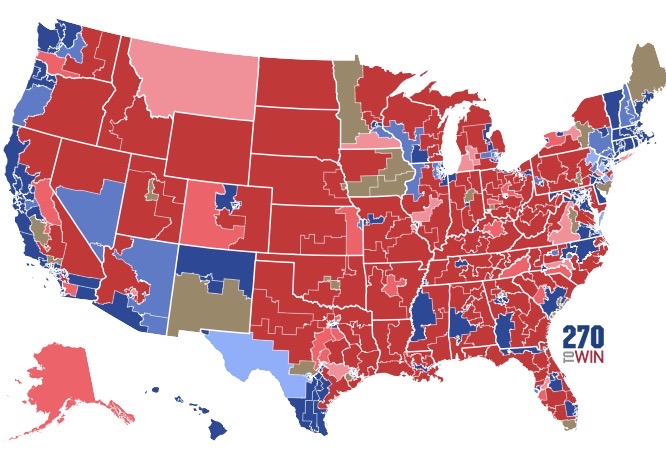Vision 2020: Congressional Races
Every four years the Presidential election captures the spotlight but Congressional races are also of great importance to decision making in Washington DC. If President Donald Trump is reelected, the Senate will likely remain in GOP hands. The House of Representatives is a more complicated matter. The Democrats could retain control of the House even if the President prevails.
In the most recent article in this series I discussed the history of Presidential elections and the high likelihood of victory for incumbents seeking reelection. In this article, I will look into the congressional races to examine the likely outcomes of Senate and House of Representatives elections this year.
United States Senate
The Constitution establishes a six-year term for members of the Senate and rotates them such that about 1/3rd of the Senate seats are up for election each year. There are 35 seats on the ballot this year (due to special elections in Georgia and Arizona – normally there are 33 seats in class II). The GOP is defending 23 seats and the Democrats will be defending 12. Three Republican Senators are retiring in Wyoming, Kansas, and Tennessee all safe Republican states. The Democrats have only one retiring Senator in New Mexico, likewise a safe Democrat State. Thus, all of the contested seats in this election will involve an incumbent from one or the other party.

Polls from typical polling agencies show significant left bias, especially when they poll beyond “likely voters;” those who might actually vote. It is difficult to gauge precisely where these races stand at the moment. It is also true that if President Trump is reelected this year there will be higher voter turnout in his favor that will benefit the GOP. That may not be true in all cases, however, since many voters in President Trump’s coalition are not otherwise supporters of the Republican Party. It can be stated in general, however, that if the President is reelected, the GOP will likely retain control of the Senate.
Doug Jones (D-AL) won a special election in 2017 to become the Senator from Alabama. The much publicized election involved unproven allegations of sexual misconduct by GOP nominee Judge Roy Moore. This year Jones will face Tommy Tuberville, a college football coach who is a more upstanding and mainstream GOP candidate. Jones has voted with the far left on controversial issues including abortion, and the vote to remove President Trump from the Presidency at the conclusion of the Impeachment trial. He has not made an effort to bill himself as a moderate like Senator Joe Manchin (D-WV). In all likelihood the GOP will reclaim this seat in Alabama.
The GOP may also gain a second seat in Michigan. Senator Gary Peters has nearly completed his first term as the junior Senator from Michigan. Strangely, few residents of Michigan even know his name. His lack of notoriety may hurt him since his opponent is the war veteran and businessman John James. James is a celebrated African-American GOP candidate who ran for Senate in 2018 against Debbie Stabenow (D-MI). In what should have been a blow out reelection with a well known and established incumbent during a year in which the Democrats made significant electoral gains, James narrowed the margin of victory to a mere 6.5% (less than 300,000 votes out of over 4 million cast).
The GOP is also defending several seats that might be tight this election. Susan Collins (R-ME) has generally won by wide margins based upon her moderate, center of the road politics. The last several years have been anything but kind to the Senator’s approach. She has had to take controversial stands on several key votes including her vote to confirm Supreme Court Justice Brett Kavanaugh and her vote against removing Donald Trump from office. Will this imperil her reelection prospects? It might, but it is more likely that she will weather this crisis and retain her office. While the media makes much of her perceived weakness, Susan Collins is an established incumbent who is likely to win reelection even if Maine votes for Joe Biden in November.
In North Carolina first term incumbent Thom Tillis (R-NC), who defeated Kay Hagan in 2014, will face off against Democrat State Senator Carl Cunningham. North Carolina is a battleground state for the presidential election and the Senate race is likely to be close as well. Here, the question may come down to how many voters turn out to vote for President Trump. If Joe Biden were to carry North Carolina there is a good chance the Democrats would gain this seat.
The media has made something of Joni Ernst’s (R-IA) purported vulnerability in Iowa. Senator Ernst is a rising star in the GOP but she has served only a single term in office. Polls may suggest Iowa to be closer than it actually is. Many farmers were hurt early on by the trade war with China. Now, as China begins to play ball with President Trump’s trade deal circumstances have improved for farmers. Nevertheless, much like North Carolina, as goes the Presidential race in Iowa, very likely so too goes the Senate race.
Colorado is a state where a very real vulnerability exists for the GOP. Colorado has been voting regularly for the Democrats since 2008. Senator Cory Gardner (R-CO) is up against former Democrat Governor John Hickenlooper. The Governor’s campaign has been beset with scandal from the outset but this does not always hamper Democrat candidates. Since Colorado is likely to go to Joe Biden and Gardner is facing a popular former governor, Gardner’s reelection is certainly an uphill battle. Could Coloradans buck the trend and vote for Biden while also reelecting Gardner? Anything is possible, but this scenario is unlikely. If by some surprise President Trump were to win Colorado, Senator Gardner would likely be reelected. If any incumbent GOP Senator is truly vulnerable this year, this is the seat to watch.
Arizona is also a point of vulnerability for the GOP. In 2018 incumbent Jeff Flake chose not to seek reelection; he was polling very poorly in the GOP primary. He has gone on to endorse Joe Biden this year. The GOP chose veteran Martha McSally (R-AZ) to run for the seat. McSally was the Air Force’s first female combat pilot. The Democrats went with former Green Party activist and Congresswoman Krysten Sinema (D-AZ), a media darling whom they billed as a moderate. In the 2018 malaise Sinema narrowly carried the day. Governor Doug Ducey, however, then appointed Martha McSally to the seat vacated by John McCain. A seat that will be on the ballot in 2020 and again in 2022 when the seat would have faced its regular election. Thus, McSally is a Senator from Arizona, but not quite an incumbent since she did not win her last senate race. McSally will face an uphill challenge from Astronaut Mark Kelly. Arizona is likely to be a Trump state in 2020, but Arizonans may nevertheless be unkind to McSally. Governor Ducey won reelection by a wide margin in 2018 demonstrating the willingness of Arizona voters to split their ballots. Arizona could very well go to Trump and at the same time elect Mark Kelly to the Senate denying the GOP yet another seat.
In the Senate, the GOP may gain two seats and could very well lose two as well, leading to no change in the 53-47 majority. If Gardner or McSally should win, the GOP could gain a seat or two. Either way, if President Trump is reelected, he is likely to retain a friendly Senate to confirm his judicial nominees and cabinet appointments.

The House of Representatives
The House is another matter entirely. In 2012, President Obama was overwhelmingly reelected as the Democrats gained two seats in the Senate. The GOP retained control of the House regardless. It is very likely that the Democrats will lose seats in the House this year but they could maintain a narrow majority. The Republicans currently hold 198 seats in the House out of the 435 total, and would thus have to gain 20 seats to reach 218, the most razor thin of majorities. Thus, the GOP would need to gain more like 25 to 30 seats to have a comfortable majority. This is not impossible and again it depends greatly on how turnout goes for the Presidential election. The Democrats gained 38 seats in the 2018 midterms after more than 40 GOP incumbents chose not to seek reelection. This year, however, there are not a great many Democrat incumbents calling it quits. Meaning the GOP must defeat well seated incumbents to win back the majority.
Twelve of the 38 seats the Democrats gained in 2018 were won with the narrowest of razor thin margins. These include seats in Oklahoma and Kansas, Maine’s 2nd, the large southern district in New Mexico, and several seats in Orange County, California. Some of these twelve seats could come back to the GOP this year with higher voter turnout. Even if all twelve flipped, this would still leave the GOP short of the majority. There are a few embattled Democrats who will face tough reelection campaigns. I will highlight a few here but this is by no means comprehensive, it is simply a sampling that indicates how things could turn out.
Minnesota’s has two embattled incumbents, one of whom you have almost certainly heard about. Ilhan Omar is the Somali immigrant who holds the 5th Congressional seat in Minnesota. She is a member of the radical “Squad” led by Alexandria Ocasio-Cortez (AOC) and has been called out for spreading antisemitic conspiracy theories. The 5th District is in the Minneapolis area wherein the recent riots are likely to be foremost on the minds of voters. Omar will face GOP challenger Lacy Johnson, an African-American businessman with strong ties in the district.
7th District has been held by Collin Peterson for 15 terms (since 1991). The district he represents covers western Minnesota and it went to President Trump by over 30% in 2016, although he narrowly lost the state overall. Former Lt. Governor and State Senator Michelle Fishbach won the GOP primary and is in a strong position to oust Peterson. If the GOP can win more seats like this one, there is a chance of recapturing the House. As with many of the tight Senate races, if Minnesota were to be won by President Trump in 2020 it would go a long way to adding a pair of House seats to the GOP tally. If Trump wins Minnesota, the GOP could pick up the state’s Senate seat and up to two seats in the House.
Iowa’s 1st Congressional District was another narrow win for the Democrats in 2018. Democrat Abby Finkenaur now represents the seat. She faces GOP nominee and news anchor Ashley Hinson. Hinson is highlighting the radical policies of the Democrats to gain advantage in the race.
The conservative leaning 2nd Congressional District may be another opportunity for the GOP to gain. Incumbent David Loebsack is retiring after serving seven terms in the House. GOP candidate State Senator Dr. Marianette Miller-Meeks is running against Democrat State Senator Rita Hart. Hart has a 2-1 advantage in fundraising at the moment over Miller-Meeks but that may not be terminal in this case.
Iowa’s 3rd Congressional district was one of those narrowly gained by the Democrats in 2018 when Cindy Axne won. David Young, the GOP candidate, held the seat for four years before he was ousted by Axne by 2% points (about 12,000 votes out of 350,000 cast). Young is seeking to regain his seat in Congress. He has a good chance of doing just that. Young has been drawing parallels between Axne’s positions to those of Speaker Nancy Pelosi, which are deeply out of touch with the values of ordinary Iowans. Once again, so goes Iowa in the Presidential race, so too may go its congressional seats.
New York’s 22nd Congressional District is also one narrowly won by Democrat Anthony Brindisi in 2018. The Upstate district was represented by Republican congresswoman Claudia Tenney who is running to reclaim her seat.
In the southern California 39th Congressional district Republican Young Kim is likewise running again after a narrow defeat in 2018. Democrat Gil Cisneros took the seat by 3.2% in 2018. If Kim is elected she will represent a significant gain for the GOP and for Asian-American Republicans.
Is a Sweep on the Table?
The GOP now led by Donald Trump could very well sweep the Democrats from power in the federal government this year. If so, it will mean a landslide in the Electoral College for Trump, some back and forth in Senate seats that will leave the GOP on top, and a desperate battle for seats in the House of Representatives. If voters are truly, utterly disgusted with the riots, race baiting, and intolerance of the Democrats over the past four years, they may very well hand them the kind of defeat they rightly deserve. In the meantime, supporters of the President and the GOP cannot take anything for granted. Every supporter will need to give dollars, make phone calls, and knock doors in order to aid the effort. Every Trump voter will need to appear at the polls or cast their absentee ballot. Nothing can be taken for granted.






